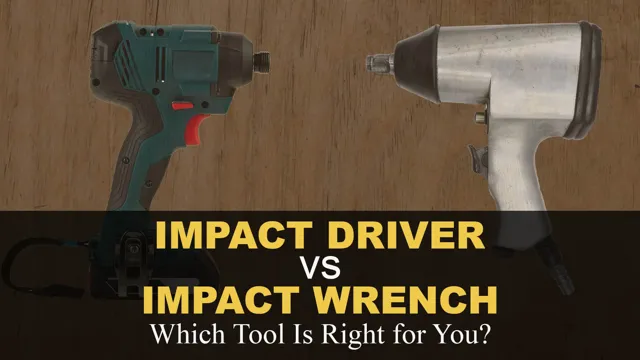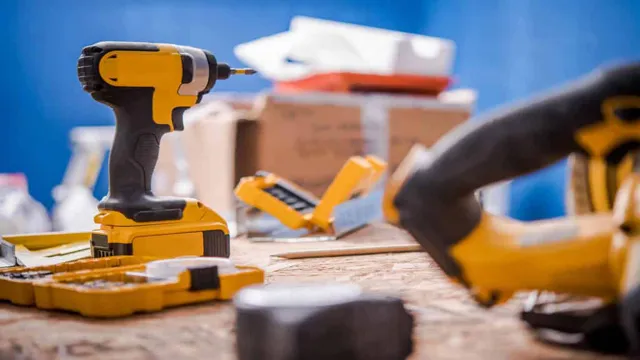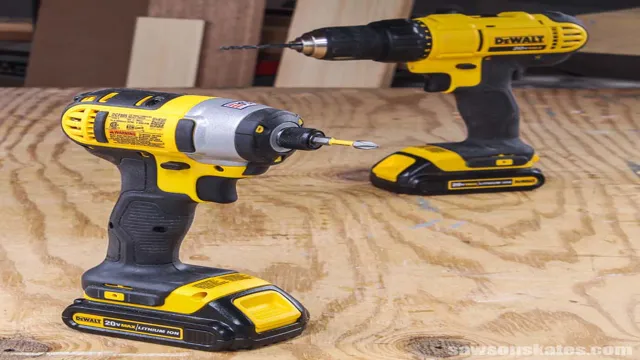What is Better: A Drill or Impact Driver? The Ultimate Comparison Guide
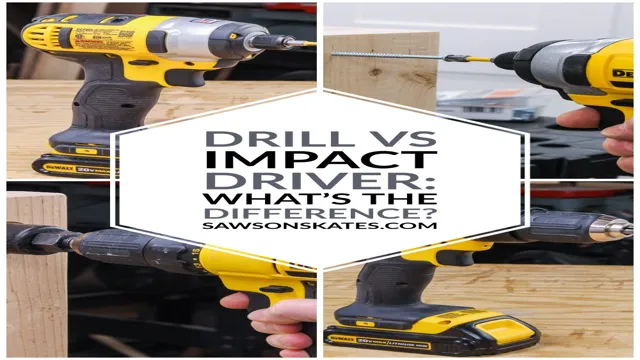
When it comes to DIY projects and repair jobs, having the right tools is crucial. Two of the most important tools are a drill and an impact driver. Many people often wonder which tool is better suited for their needs.
While both tools are essential in their own ways, they have their differences. In this article, we’ll explore the differences between a drill and an impact driver, and help you determine which tool is better for your particular application. So, let’s break it down and see which one comes out on top.
Overview of Drill and Impact Driver
When it comes to choosing between a drill and an impact driver, the answer largely depends on the task at hand. If you need to drill holes into wood, metal, or other materials, a drill is a great option. It has a chuck which can hold different sizes and types of bits, making it versatile for a wide range of projects.
However, if you need to drive screws into tough materials like hardwood or concrete, an impact driver is the better choice. It generates a strong rotational force that makes driving screws much easier and faster. Impact drivers also have a collet system that makes it easier to change out bits quickly.
That being said, some tasks require a combination of both tools – for example, if you need to pre-drill holes before driving screws. Ultimately, the decision between a drill and impact driver comes down to what kind of project you’re working on and what kind of tasks you need to accomplish.
Explanation of What is a Drill
A drill is a tool utilized for drilling holes or driving screws into surfaces, like wood, metal, or concrete. It is designed to provide rotational force to a drill bit, mainly through an electric motor, enabling the bit to cut through the material and create a hole. Conversely, an impact driver is a similar tool but primarily used for driving screws with more power and torque.
Instead of just rotational force, an impact driver delivers bursts of axial force that create up to 3x more torque than a traditional drill driver. Both tools are essential in any DIY or construction project, and knowing the differences between them can help you choose the right one for your specific needs. Whether you need to bore holes in drywall or attach heavy-duty hardware to concrete, a good quality drill or impact driver can help make the job easier and faster.
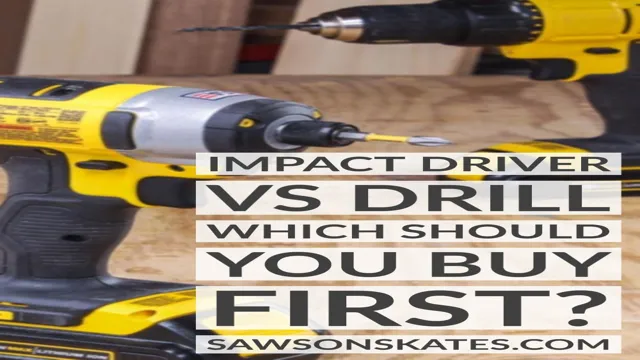
Explanation of What is an Impact Driver
If you’re wondering what an impact driver is, let’s start with a brief overview of a drill and an impact driver. A drill is a versatile tool that can be used for drilling holes and driving screws into wood or other materials. However, a drill can sometimes struggle when it comes to driving screws into harder materials like metal or dense hardwood.
This is where an impact driver comes in. An impact driver is a tool that uses rotational force to quickly and easily drive screws into tough materials without stripping or damaging the screw head. In essence, an impact driver is like a drill on steroids.
It’s an indispensable tool for any serious DIY enthusiast or professional contractor who wants to get the job done quickly and efficiently. So, if you’re tackling a tough drilling or screw-driving job, you’ll want to consider adding an impact driver to your tool collection. Trust us, you won’t be disappointed!
Comparison Between Drill and Impact Driver
When it comes to choosing between a drill or impact driver, the answer isn’t always straightforward. Both tools have their own unique strengths, and it really depends on what you’re planning on using them for. If you’re working on projects that require a lot of drilling, then a drill is probably the better choice.
But if you need to drive screws into tougher materials, an impact driver might be the way to go. The main advantage of an impact driver is that it provides more torque than a drill, making it easier to drive screws into harder materials. Additionally, an impact driver usually has a quick-release chuck, which makes it easier to switch out drill bits and screwdriver bits on the fly.
However, when it comes to precision drilling, a drill is still the better choice, as it’s easier to control the speed and depth of the drill bit. Ultimately, the choice between a drill and impact driver depends on your specific needs and the type of projects you plan on working on.
Speed and Torque Comparison
When it comes to power tools, there are so many options available in the market, and it can be challenging to pick the right one. Among those options are drills and impact drivers, two tools that are commonly used for DIY and construction projects. Both tools are extremely powerful, each with its own unique advantages and disadvantages.
One thing to consider when deciding between a drill and an impact driver is their speed and torque capabilities. A drill typically has a lower torque but a higher speed, making it ideal for drilling into softer surfaces like wood or plastic. On the other hand, an impact driver has a higher torque but a lower speed, making it perfect for driving screws and bolts into hard materials like concrete or steel.
In general, if you require a tool that performs well in both areas, a drill is the better option. However, if you need a tool specifically for driving screws and bolts into hard surfaces, then an impact driver is the way to go. Ultimately, the decision comes down to what your project demands and which tool will get the job done most efficiently.
Screw Driving Comparison
When it comes to screw driving, there are two popular tools that come to mind: the drill and the impact driver. While they may look similar, they each have their own strengths and weaknesses that make them better suited for specific tasks. First, let’s talk about the drill.
This tool is great for drilling holes and driving screws into soft materials like wood and drywall. It has a chuck that allows you to change out bits depending on the size and shape of the hole you need to drill. Some drills even have a clutch setting that allows you to control the depth of your screws.
However, when it comes to tougher materials like metal or concrete, the drill’s power may not be enough to get the job done efficiently. This is where the impact driver comes in. It’s designed to provide more torque and can handle more heavy-duty driving tasks.
The impact driver uses a combination of rotational force and concussive blows to turn screws into material quickly and easily. It also has a hexagonal chuck that accepts 1/4 inch hex bits, making it perfect for driving screws in tight spaces and awkward angles. To sum it up, the drill is best for drilling holes and driving screws in soft materials, while the impact driver is better suited for driving screws in tougher materials.
Depending on the task at hand, you may find yourself reaching for one tool more than the other. Ultimately, both the drill and impact driver are versatile and useful additions to any DIYer or handyman’s tool collection.
Drilling Comparison
When it comes to drilling, two of the most popular tools are the drill and the impact driver. While both are used for drilling holes, they have some significant differences. The main difference between the two tools is the way they operate.
A drill functions by rotating while an impact driver combines rotational force with concussive blows. This difference makes the impact driver more powerful but less precise than a drill. If you need to drill large and deep holes, then a drill is the best choice.
However, if you need to drive screws or fastenings, then an impact driver is the way to go since it exerts a high amount of torque and can work through tough materials. Overall, both tools have their unique uses, and the right tool depends on the job at hand.
When to Use a Drill or Impact Driver
If you’re wondering what is better, a drill or impact driver, the answer is that it depends on the task at hand. Both tools are great for screws and drilling, but they have different strengths. In general, drills are better for tasks that require precision, such as drilling small holes or working with delicate materials.
On the other hand, impact drivers are better suited for heavy-duty jobs, such as driving long screws or working with dense materials. The burst of energy that an impact driver provides makes it ideal for tasks that require more power. Both tools have their benefits, and it’s up to you to decide which one is best for the job.
If you have a large project that requires both precision and power, it may be a good idea to have both tools on hand to switch between them as needed. Overall, both tools are essential for any DIY enthusiast or handyman, and choosing the right one for the job can make all the difference.
Drill Use Cases and Benefits
When it comes to deciding whether to use a drill or impact driver, there are a few factors to consider. Drills are great for drilling holes and driving screws into wood, drywall, and other soft materials. Impact drivers are better suited for heavy-duty projects involving metal or thick wood.
Think of it this way: a drill is like a knife, precise and effective, while an impact driver is like a hammer, delivering powerful, quick blows to get the job done. Another thing to keep in mind is that impact drivers are typically louder and more forceful, so they may not be ideal for delicate jobs. Ultimately, the decision comes down to the specific task at hand, but having both options in your toolbox can prove incredibly useful in different scenarios.
Impact Driver Use Cases and Benefits
When it comes to DIY projects, knowing whether to use a drill or an impact driver can make a big difference. While both tools are similar, they each have their strengths. A drill is best for making small holes and driving screws into soft materials like wood or drywall.
On the other hand, an impact driver is better suited for tough jobs that require more power, like driving large screws and bolts into harder materials like metal. Impact drivers are also more effective at breaking rusty or stuck screws loose, making them a great tool for renovation projects. So, if you’re working on a project that requires a lot of heavy-duty driving or drilling, an impact driver is the way to go.
Not only will it save you time and effort, but it’s also less likely to strip screws or damage materials. Invest in a quality impact driver, and you’ll wonder how you ever tackled DIY projects without it.
Conclusion
In the battle of the drill vs. impact driver, it’s like choosing between a spoon and a fork. Both have useful functions and can do the job, but one may be better suited for certain tasks.
The drill is like a trusty spoon, great for stirring and mixing, while the impact driver is like a fancy fork, perfect for stabbing and loosening. Ultimately, choosing the right tool depends on your specific needs and preferences. So, put down the spork and pick up either the drill or impact driver, and let’s get to work!”
FAQs
What is the difference between a drill and an impact driver?
A drill is best suited for drilling and driving screws into softer materials, while an impact driver is better for driving screws into harder materials like metal or concrete.
Can an impact driver replace a drill?
While an impact driver can do the job of a drill in some cases, it cannot replace a drill entirely as it lacks the versatility and precision of a drill.
Which is better for DIY projects, a drill or an impact driver?
For DIY projects that involve simple drilling and screw driving tasks, a drill is best. However, for more heavy-duty projects that involve working with tough materials, an impact driver is better.
Do impact drivers require special bits?
While regular drill bits can be used with impact drivers, it is recommended to use impact-rated bits as they can withstand the high torque generated by the impact driver.
Are impact drivers more expensive than drills?
Impact drivers can be more expensive than drills, but the extra cost is worth it if you frequently work with tough materials that require a high torque tool.
Do impact drivers have adjustable torque settings?
Most impact drivers do not have adjustable torque settings, but some models have different speed settings to control the torque output.
Can impact drivers be used for delicate tasks like assembling furniture?
Impact drivers are not recommended for delicate tasks like assembling furniture as they can easily strip screws or damage the material. A drill is better suited for these types of tasks.
